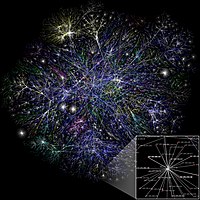
Photo from wikipedia
Network models for disease transmission and dynamics are popular because they are among the simplest agent-based models. Highly heterogeneous populations (in the number of contacts) may be modeled by networks… Click to show full abstract
Network models for disease transmission and dynamics are popular because they are among the simplest agent-based models. Highly heterogeneous populations (in the number of contacts) may be modeled by networks with long-tailed degree distributions for which the variance is much greater than the mean degree. An example is given by scale-free networks where the degree distribution follows a power law. In these type of networks there is not a typical degree. Some nodes may have low representation in the population but are key to drive disease transmission. Coarse graining may be used to simplify these complex networks. In this work we present a simple model consisting in of a network where nodes have only two possible degrees, a low degree close to the mean degree and a high degree about ten times the mean degree. We show that in spite of this extreme simplification, main features of disease dynamics in scale-free networks are well captured by our model.
Journal Title: Journal of theoretical biology
Year Published: 2019
Link to full text (if available)
Share on Social Media: Sign Up to like & get
recommendations!